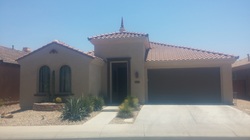
Answer: Highlight this paragraph to see the answer in white text. the re-circulation pump on the water heater was set "ON" 24-7.
|
An all electric, 1700 sq ft home in Phoenix, AZ was recently built in 2008. The average pressure pan was found to be 0.6 Pa with a static pressure of 0.4 IWC on the return and 0.2 IWC on the supply. The summer and winter temperatures are kept at 78 degrees and 68 degrees and 2 people live in the house. There is no pool but there is a recirculation pump on the water heater. Windows are dual pane, low-e but they do get 4 hours of western sun exposure. Attic insulation was found to be aligned and at R-36 on average along the attic floor.  What would be the cause of a $450 energy bill in July? Answer: Highlight this paragraph to see the answer in white text. the re-circulation pump on the water heater was set "ON" 24-7. Looking for answers to your BPI exam classes? Check out our 25 free BPI Practice Exam Questions or take our 100 question practice exam here.
5 Comments
ben
1/7/2016 06:40:44 am
wouldn't they have high bills every month not just a spike in July with it set on 24/7 on?
Reply
David
1/11/2016 05:53:56 am
Yes, they would have high bills the entire year with the re-circulation pump @ben, it was $220 in the winter.
Reply
Brad
2/15/2016 11:01:30 am
Were the electric bills examined over a three year period or just one year?
Reply
David
2/15/2016 02:40:23 pm
@Brad good question, we looked at only one year but the homeowner did not mention they had a recent spike in their energy bills so they may have always been high.
Reply
larry cole
3/19/2016 10:31:19 am
It sounds like the water heater is cycling to much due to the circulating pump running all the time or the water heater thermostat has failed.
Reply
Leave a Reply. |
David ByrnesOwns and operates Green ID, a residential home energy auditing and contracting company in Phoenix, AZ. He is a BPI Proctor and has trained over 40 energy auditors. Get The Latest Blog UpdatesArchives
November 2017
|
|
Copyright 2023 Building Science Training Center LLC
|